备考2011高效学习方案英语高一册:unit 2 english around the world
文档属性
| 名称 | 备考2011高效学习方案英语高一册:unit 2 english around the world | 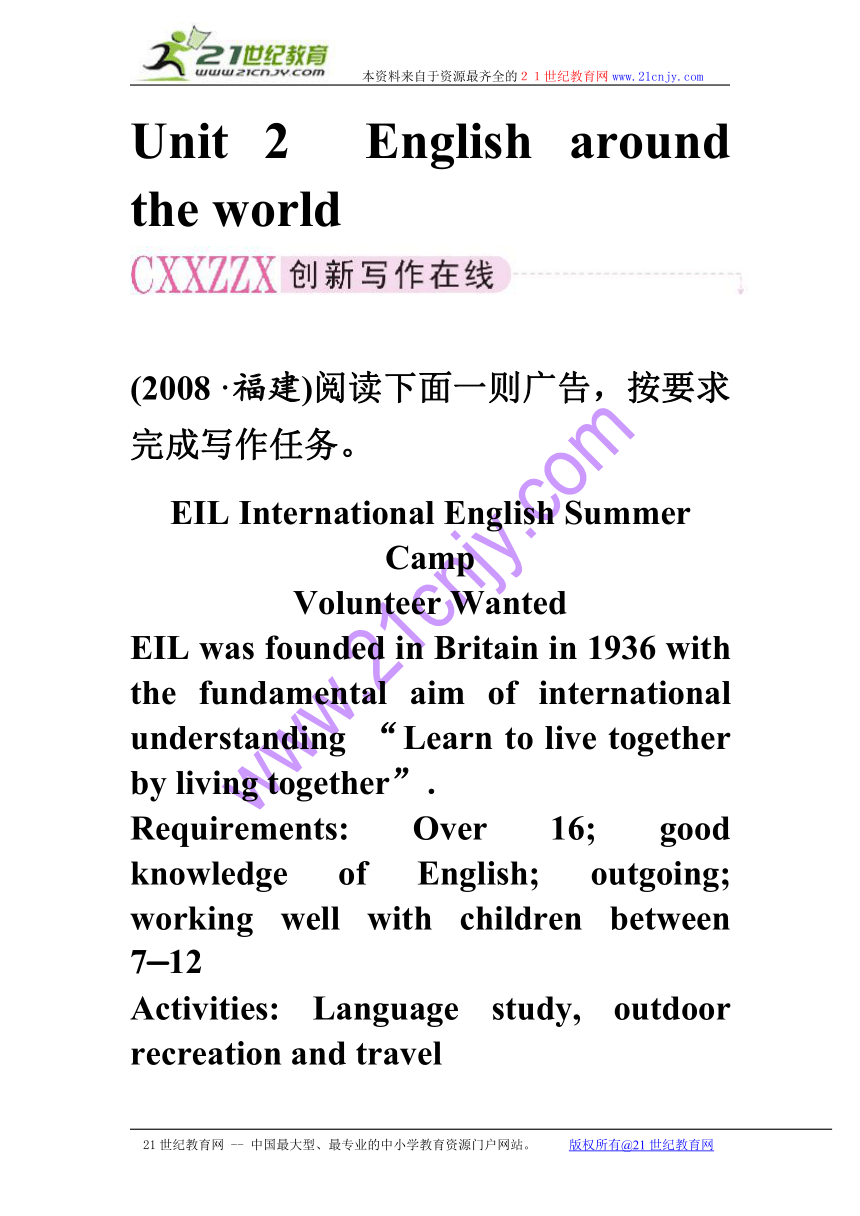 | |
| 格式 | rar | ||
| 文件大小 | 279.5KB | ||
| 资源类型 | 教案 | ||
| 版本资源 | 人教版 | ||
| 科目 | 英语 | ||
| 更新时间 | 2010-12-14 17:12:00 | ||
图片预览

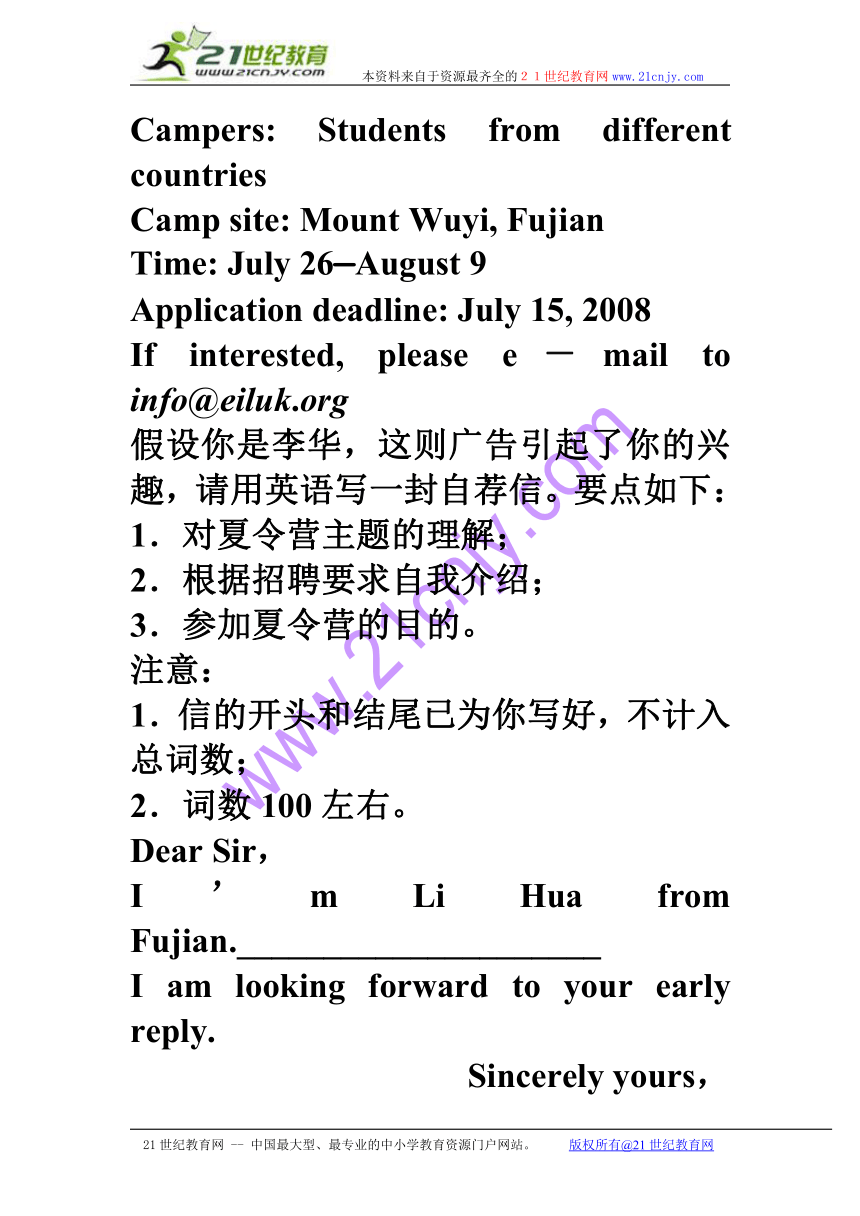
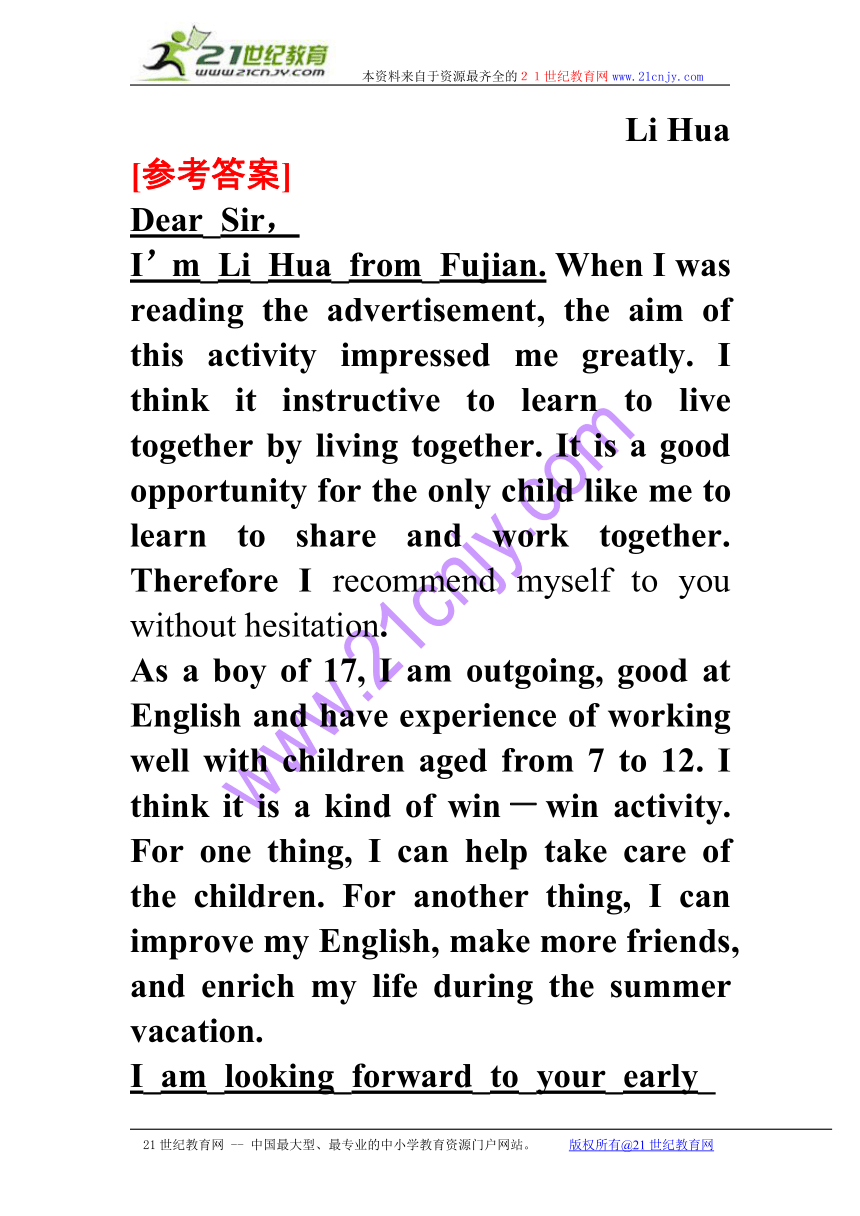
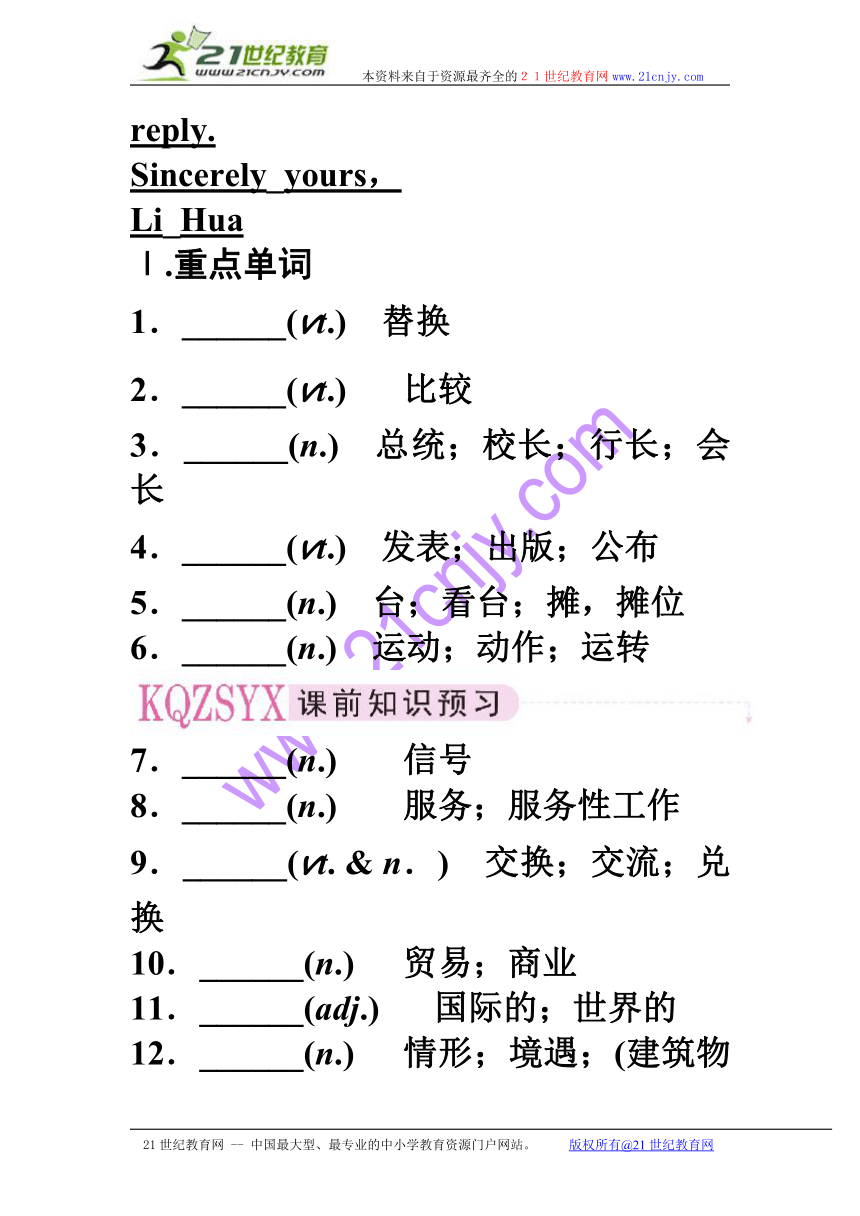
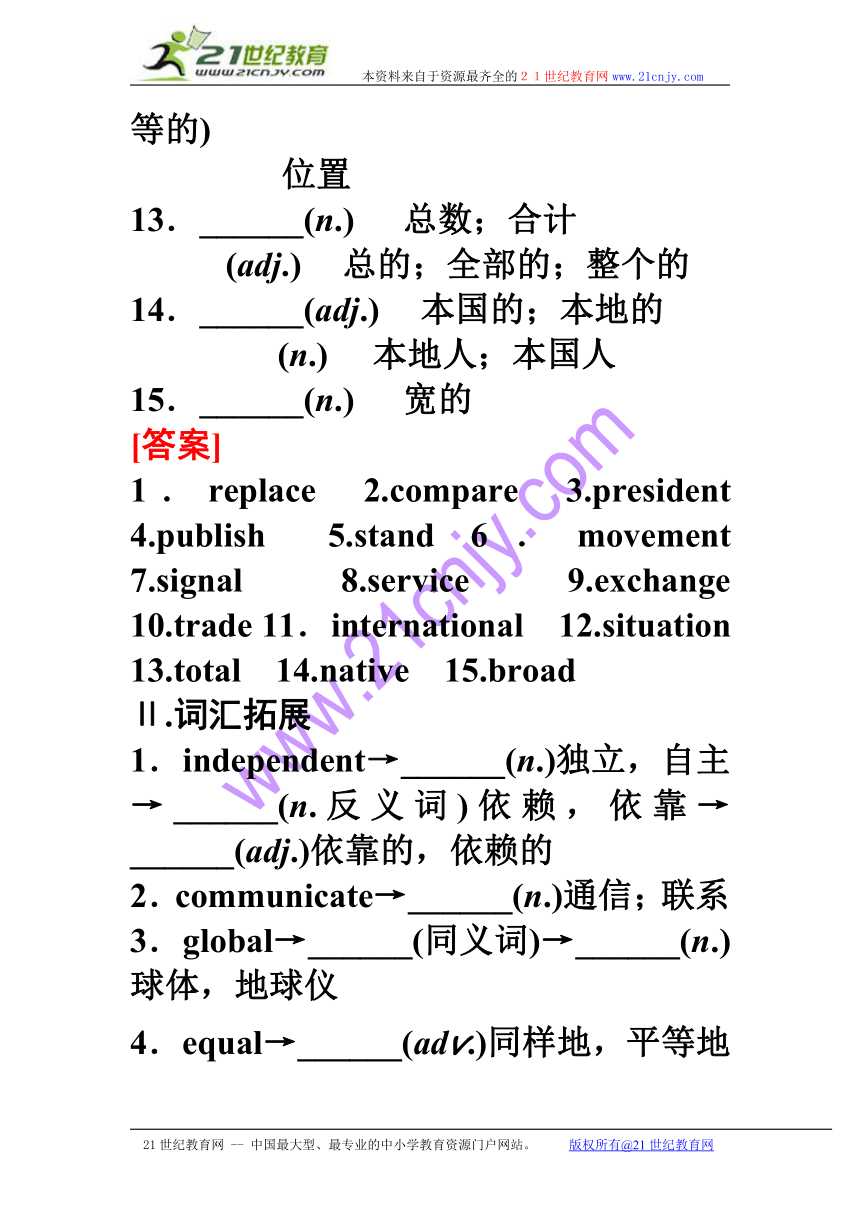
文档简介
本资料来自于资源最齐全的21世纪教育网www.21cnjy.com
Unit 2 English around the world
(2008·福建)阅读下面一则广告,按要求完成写作任务。
EIL International English Summer Camp
Volunteer Wanted
EIL was founded in Britain in 1936 with the fundamental aim of international understanding “Learn to live together by living together”.
Requirements: Over 16; good knowledge of English; outgoing; working well with children between 7—12
Activities: Language study, outdoor recreation and travel
Campers: Students from different countries
Camp site: Mount Wuyi, Fujian
Time: July 26—August 9
Application deadline: July 15, 2008
If interested, please e-mail to info@eiluk.org
假设你是李华,这则广告引起了你的兴趣,请用英语写一封自荐信。要点如下:
1.对夏令营主题的理解;
2.根据招聘要求自我介绍;
3.参加夏令营的目的。
注意:
1.信的开头和结尾已为你写好,不计入总词数;
2.词数100左右。
Dear Sir,
I’m Li Hua from Fujian._____________________
I am looking forward to your early reply.
Sincerely yours,
Li Hua
[参考答案]
Dear_Sir,
I’m_Li_Hua_from_Fujian. When I was reading the advertisement, the aim of this activity impressed me greatly. I think it instructive to learn to live together by living together. It is a good opportunity for the only child like me to learn to share and work together. Therefore I recommend myself to you without hesitation.
As a boy of 17, I am outgoing, good at English and have experience of working well with children aged from 7 to 12. I think it is a kind of win-win activity. For one thing, I can help take care of the children. For another thing, I can improve my English, make more friends, and enrich my life during the summer vacation.
I_am_looking_forward_to_your_early_reply.
Sincerely_yours,
Li_Hua
Ⅰ.重点单词
1.______(vt.) 替换
2.______(vt.) 比较
3.______(n.) 总统;校长;行长;会长
4.______(vt.) 发表;出版;公布
5.______(n.) 台;看台;摊,摊位
6.______(n.) 运动;动作;运转
7.______(n.) 信号
8.______(n.) 服务;服务性工作
9.______(vt. & n.) 交换;交流;兑换
10.______(n.) 贸易;商业
11.______(adj.) 国际的;世界的
12.______(n.) 情形;境遇;(建筑物等的)
位置
13.______(n.) 总数;合计
(adj.) 总的;全部的;整个的
14.______(adj.) 本国的;本地的
(n.) 本地人;本国人
15.______(n.) 宽的
[答案]
1.replace 2.compare 3.president 4.publish 5.stand 6.movement 7.signal 8.service 9.exchange 10.trade 11.international 12.situation 13.total 14.native 15.broad
Ⅱ.词汇拓展
1.independent→______(n.)独立,自主→______(n.反义词)依赖,依靠→______(adj.)依靠的,依赖的
2.communicate→______(n.)通信;联系
3.global→______(同义词)→______(n.)球体,地球仪
4.equal→______(adv.)同样地,平等地→______(n.)平等
5.majority→______(反义词)少数
6.repeat→______(n.)重复
7.pronounce→______(n.)发音;发音方法
[答案]
1.independence; dependence; dependent 2.communication 3.worldwide; globe 4.equally; equality 5.minority 6.repetition 7.pronunciation
Ⅲ.重点短语
1.______ the same 保持一样
2.have (no) difficulty in ______ sth.做某事(没有)有困难
3.more ______ less 或多或少
4.be different ______ 与……不同
5.communicate ______ 与……交流
6.______ than 超过,不仅仅
7.a great ______ 许许多多的;极多的
8.bring ______ 引进;引来
9.end ______ 以……告终
10.come ______ 发生
11.stay ______ 不睡;熬夜
12.except ______ 除了……之外
13.______ total 总共
14.______ oneself at home 别客气
[答案]
1.stay 2.doing 3.or 4.from 5.with 6.more
7.many 8.in 9.up 10.about 11.up 12.for
13.in 14.make
Ⅳ.重点句型
1.What do you mean by...
你……是什么意思?
2.more than的有关句型
Ⅴ.重点语法
Direct and Indirect Speech—(Imperative Sentence)
直接引语和间接引语——祈使句
Ⅰ.词汇聚焦
1.majority n. 大多数
[思维拓展]
①the/a majority (of...)大多数(……)
most+名词 多数……
③mostly+形容词/副词 主要地/多半……
[指点迷津]
majority作主语时,谓语动词的数取决于其后的名词或句子的意思。若强调由个体组成的“大多数”,谓语动词用复数;若强调整体时,则谓语动词用单数。
The majority of students ______ ______ favour of his suggestion.
A. are; in B. is; in
C. are; for D. are; at
解析:students是复数形式,故谓语动词用are。in favour of“支持,拥护”,是固定结构。
答案:A
2.native n. 当地人;adj. 出生地的
[思维拓展]
a native of London/Beijing伦敦/北京的本地人
speak/act like a native像当地人一样说/做
one’s native language/tongue母语
be native to...原产于某地
go native to...原产于某地
go native同化(指文化、风俗等)
3.equal adj. 相当的;v. 等于;比得上
[思维拓展]
divide/cut sth. into equal parts把某物分成/切成等份
with equal ease同样自如(做某事)
equal to sth./doing sth.胜任某事
on equal terms with sb.与某人平等相处
equally adv. 平等地;同样
equality n. 平等
4.forget v. 忘记
[思维拓展]
In some parts of London, missing a bus means ______ for another hour.
A. waiting B. to wait
C. wait D. to be waiting
解析:根据题意“……没赶上公共汽车就意味着再等一小时”知该题考查“mean+doing”结构的意义。
答案:A
5.total n. 总共,总计;adj. 全部的
[思维拓展]
a total of 94 people总共94人
in total(=in all=altogether=all together=totally)总共,总计
the total cost/debts/amount/population总共花费/债务/总量/人口总数
a total failure/stranger彻底的失败者/完全陌生的人
in total silence完全沉默
total (up to)(=come to=amount to=add up to=reach)总计,总数是(无被动)
—How many monkeys are there in the zoo
—The number of monkeys there ______ ten, ______ the newly-born ones.
A. come to; including
B. has reached; including
C. is totalled; including
D. has added up; including
解析:句子的意思是“包括刚出生的,猴子的数量是十只。”“总计”可以用come to, total, reach, add up to但是不能用被动语态,而且句子主语the number是单数;此处including放在被包括的事物前,included放在被包括的事物之后。
答案:B
6.service n. 服务
[思维拓展]
free medical service免费医疗
the telephone service电话设施
China Travel Service中国旅行社
a marriage service婚礼
at one’s service听某人差遣,任凭某人使用
in service被雇佣着;在服兵役
of service (to sb.)(对某人)有用的,有帮助的
service charge服务费
If you ever need my help, I am ______.
A. at your service B. of your service
C. in service D. serving
解析:题意应是:你要是什么时候需要我帮助,我随时可以帮你。at one’s service=ready to help sb.。
答案:A
7.stand n. 看台;v. 站,支持
[思维拓展]
stand aside靠边站,避开
stand by站在/立在……旁边
stand away保持距离,不接近
stand against反对,背靠着,倚着……站立
stand (up) for维护,起来拥护
stand up to敢于面对,经得起,耐得住
stand out显眼,出色
(outstanding adj. 出色的,显著的)
stand up起立
stand back避开;往后站,位于靠后的地方
stand on one’s hands双手倒立
stand on one hand/leg/foot单手/腿/脚立
[指点迷津]
represent作“象征,代表”解时,是及物动词,可以使用被动语态。
stand for不可以使用被动语态。
There are 51 stars on America’s national flag, each ______ a state.
A. standing for B. stands for
C. represented D. to represent
解析:句子的意思是“美国的国旗上有51颗星,每一颗星代表一个州。”由于句中使用逗号,each后面的动词不能作谓语,只能是独立主格的形式,又因为each与stand for是逻辑上主谓关系,所以用standing for或representing。
答案:A
8.lie vi. 躺,卧;位于
[思维拓展]
lie in bed 卧病在床
lie in在于,存在于
lie down躺下
lie on one’s side侧卧
lie on one’s back仰面朝上躺着
lie on one’s face/stomach趴着
[指点迷津]
lie
lay vt. laid—laid—laying平放,搁置;产卵,下蛋
lie to sb. (=tell a lie to sb./tell lies to sb.)说谎
lay eggs产卵,下蛋
lay the table摆放桌子(准备吃饭)
The boy ______ in bed ______ to his father that he had ______ the book on the table.
A. lying; lied; laid B. laying; laid; lied
C. lied; lay; lain D. lain; lying; laid
解析:句子意义是“躺在床上的那个男孩对他父亲撒谎说他已经把书放在桌子上了。”lying in bed是现在分词短语,作后置定语修饰the boy; lie作“撒谎”解时过去式为lied; lay是及物动词,后接宾语the book,此处用过去分词laid。
答案:A
If only he ______ quietly as the doctor instructed, he would not suffer so much now.
A. lies B. lay
C. had lain D. should lie
解析:本题考查动词lie在句子中的正确形式。If only标志后面的句子使用虚拟语气,as the doctor instructed表明事情发生在过去,因此该句是对过去的虚拟,应用had lain。注意本题考查了混合虚拟条件句,即主句与从句表达对不同时态的虚拟,解题时应按照各自的时间状语提示。
答案:C
In the dark forests ______, some large enough to hold several English towns.
A. stand many lakes B. lie many lakes
C. many lakes lie D. many lakes stand
解析:这句话是倒装句式。地点状语提前,构成全部倒装。lie表示“存在,有”;stand表示“矗立”,不符合句意。
答案:B
9.enjoy v. 从……获得乐趣;享有……
[思维拓展]
①enjoy+名词/代词
enjoy the play喜欢这部戏剧
enjoy good health享有健康
②enjoy+动名词
enjoy listening to music喜欢听音乐
③enjoy oneself过得愉快;玩得高兴
④enjoyable adj. 使人愉快的
⑤enjoyment n. 乐趣;愉快
[指点迷津]
有些动词或动词短语的后面只能接动名词作宾语,如:admit, advise, avoid, appreciate, consider, delay, finish, miss, permit, practise, enjoy, risk, imagine, allow等。
I really appreciate ______ to relax with you on this nice island.
A. to have had time B. having time
C. to have time D. to having time
解析:appreciate意为“欣赏,赞赏”,其后接动名词作宾语,而不能用不定式作宾语。
答案:B
10.expression n. 短语;表情
[思维拓展]
expression n. [U]表达,表示[C]表情;短语
expression of idea思想的表达
read with expression有表情地朗读
express vt. 表达,表示
express one’s views/ideas表达自己的观点
express oneself表达(自己的)意见/态度
express sth. to sb.向某人表示……
express (to sb.)+宾语从句向某人表示
express adj. 特快的
an express train快车
My companion ______ his surprise when he learned his ______ hadn’t arrived for such a long time.
A. expressed; luggages
B. expressed; luggage
C. described; luggages
D. described; luggage
解析:luggage“(总称)行李”,是不可数名词;express one’s surprise表示“吃惊”。describe“描写,描述”。
答案:B
11.compare v. & n. 比较,比作,对照
[思维拓展]
compare...with...将……与……做比较;对照
compare...to...把……比作……;说……像……
compared to/with...与……相比较
compare notes交换思想、观点或意见
beyond compare无与伦比
[指点迷津]
compared to/with...固定结构,作状语。
______ with the size of the whole earth, the biggest ocean doesn’t seem big at all.
A. Compare B. When comparing
C. Comparing D. When compared
解析:the biggest ocean与compare存在逻辑上的被动关系,须用过去分词短语作状语,其前的when用来突出时间意味。
答案:D
Ⅱ.短语突破
1.more than
[思维拓展]
①more than用于名词前,意为“不只是,不仅仅”。
more than a teacher不仅仅是老师
②more than用于数词前,意为“比……多”,“超过”相当于over。
more than two years超过两年
③more...than用于比较状语从句,意为“比……更……”。
She respects him more than I (do).
她比我更尊敬他。
④more...than...与其……倒不如……
She is more a friend than a teacher.与其说她是位老师还不如说是位朋友。
⑤less than不如,不像
⑥no less than不少于;多达
⑦no more+adj.+than或no+比较级+than,否定前后两者。如:no richer than=as poor as(两者都不富有)
[指点迷津]
not less than相当于“≥”,不少于,至少
not more than相当于“≤”,不多于,至多
no less than或no more than
相当于“=”,仅仅,只有
—Is Mr. White out of danger
—No, ______ than before, I’m afraid.
A. no better B. a little better
C. not worse D. no worse
解析:答语中No,暗示Mr. White健康状况并不比以前好。
答案:A
2.have a knowledge of 对……了解
[思维拓展]
have no knowledge of good and evil不分善恶/不能分辨好坏
be common/public knowledge人所共知
to one’s knowledge=as far as one knows据某人所知
3.make English different from... 使英语不同于……
[思维拓展]
“make+宾语+宾补”结构用法小结:
动词+宾语+名词/代词
常用于这种结构的动词有:find, call, name, make, elect, think, consider, leave(使处于某种状态)
动词+宾语+形容词
常用于这种结构的动词有:find, make, set, get, keep, like, see, leave(使处于某种状态),dye, cut, paint, drive, beat, prove
动词+宾语+现在分词
常用于这种结构的动词有:find, watch, notice, observe, hear, listen to, look at, keep, have(使,让),feel
动词+宾语+过去分词
常用于这种结构的动词有:find, get, make, have(使,让), see, hear
动词+宾语+不定式
常用于这种结构接带to的不定式的动词有:ask, tell, invite, force, advise, get, beg, allow, want, wish, like, order, expect, prefer, encourage, hate, warn, permit
常用于这种结构省略to的不定式的动词有:make, let, have(使,让), see, hear, watch, notice, feel, observe
动词+宾语+介词短语或副词
make sb. at home; keep sb. out; let sb. in/out; drive sb. off/out
[指点迷津]
①make/elect/choose+宾语+名词,当作宾补的名词是独一无二的职位时,该名词前不用任何冠词,这样的名词有:president, chairman, monitor, headmaster, headteacher, manager, head, captain
②make/find/feel/consider/think+宾语+名词/形容词,当宾语是从句或不定式,常用it作形式宾语,而把真正的宾语放在作宾补的名词或形容词之后,成为make/find/feel/consider/think+it+名词/形容词+从句/不定式。
③感官动词/使役动词+宾语+省to的不定式,当以被动结构出现时,作主补的不定式要带to,如be made/let/ seen/heard/watched/noticed/felt/observed+带to的不定式。
I hate ______ when people talk with their mouths full.
A. it B. that
C. these D. them
解析:本题考查it作形式宾语的用法。when people talk with their mouths full是真正宾语。若使用that则与when冲突。句子的意思是“我讨厌人们嘴里含着食物说话。”
答案:A
4.as...as... 与……一样
...he understands that friendship is about feeling and that we must give as much as we take.……他明白了这样的道理:友谊离不开感情;人既要得到关爱,又必须给他人以同样多的关爱。
[思维拓展]
as...as...表示“与……一样/同样”,第一个as为副词,用以修饰形容词、副词,第二个as可作介词或连词,后接名词、代词或句子。在否定句中也可用so...as...。
—Tom isn’t so strong as he ______, is he
—Yes. He is ______ his two brothers.
A. thinks; no stronger than
B. expects; as strong as
C. appears; stronger than
D. looks; the strongest
解析:考查比较状语从句。针对问句中的not so/as...as,回答时用yes,表示否定意“不”的意思,说明Tom比他的两个哥哥强。
答案:C
5.make oneself at home 别客气
[思维拓展]
help yourself to sth.随便拿/吃/用……
introduce oneself to...向……做自我介绍
learn by oneself自学
You will find as you read this book that you just can’t keep some of these stories to ______. You will want to share them with a friend.
A. itself B. yourself
C. himself D. themselves
解析:本题反身代词应与you保持一致,意思是:不能自我欣赏,而要与朋友欣赏。
答案:B
6.except for 除了……之外
[指点迷津]
nothing except (=nothing but=only)
①except prep. (=not including/leaving out, but not)“除……之外”,后可跟名词和从句。except后跟名词时,前面常有表示“全部”概念的词,即anyone, anything, anybody, everyone, everything, all, no one, none, nothing等。
②besides prep. (=as well as, in addition to, also)“除……之外,还有”,后跟名词时,前面常有表示“部分”概念的词,即other, another, else, more等信息词,后还可以有as well等。
③but意义同except,但它多和no, all, nobody, anywhere, everything以及who, where, what等不定代词或疑问词连用。其次,but后还可跟动词不定式(带to或省略to)构成:
There is nothing to do but do...除了做……无事可做。
There is no choice but to do...除了做……别无选择。
the last/next but one/two/three...倒数第二/第三/第四……
④except for“除了……之外”,用于排除非同类事物,其中for表示理由或细节,订正或修正某些事实。
⑤but for“要不是,若非”,常用于虚拟语气中。
⑥besides adv. “而且”,常置于句首或句尾,且用逗号与主句隔开。
I know nothing about the young lady ______ she is from Beijing.
A. except B. except that
C. except for D. besides
解析:空白处应填连接词,因其后是一从句。
答案:B
7.come about 发生,产生
[思维拓展]
How does it come about that... ……是怎样发生的?
come along/on过来,一道来
come after(=follow)跟随
come/run across sb.(=come upon sb.)(=meet with sb.)(=happen to meet sb.)(=meet sb. by chance)偶然遇见某人
come to oneself(=come back to life)苏醒过来
come to a stop(=come to an end)结束,停止
come to know(=get to know)逐渐认识
come into being(指事情、局面的)形成,出现
come into effect/force生效
come into power/office上任,就职
come true成为现实
[指点迷津]
come about“发生”,相当于happen。
happen“发生”,强调偶然性。
take place“发生”,强调必然性或按事先的安排或计划而发生。
break out“发生”,指灾难性的战争、火灾、疾病等的爆发。
occur“发生”,指意想不到的事情的发生。
上述“发生”均没有被动语态。
Please tell me how the accident ______. I am still in the dark.
A. came by B. came upon
C. came to D. came about
解析:come by“从旁走过;得到,获得”;come upon“被想出,偶然发现/遇见等”;come to“想出,达到”;come about“发生”。句意:请告诉我事故是怎样发生的,我仍然不明了。
答案:D
8.end up with 以……告终
[思维拓展]
end up with以……结束
end with以……结束
begin/start with以……开始
The meeting began ______ the national theme and also ended ______ it.
A. at; at B. with; with
C. at; with D. with; up with
解析:begin with“以……开始”;end with“以……结束”;end up with往往指有不好的结果。
答案:B
9.bring in(in为副词)主要有以下词义:
[思维拓展]
①收(庄稼等):
bring in a good harvest获得好收成
②获利,赚钱,使……得到收入
bring in a little extra income得到一点额外的收入
bring them in several hundred dollars
使他们得到几百美元的收入
③把……扯进来,把……插进来
bring in some useful sentences插入一些有用的句子
④提出,引进(话题,法案,习惯等)
bring in some reforms提出一些改革意见
bring in new customs and habits带来新的风俗习惯
[指点迷津]
bring out说明,阐明;出版(文艺作品);表现出来
bring on使发生,引起
bring up提起,提出;抚养,培养;呕吐
bring down使倒下,使下降;击落,推翻
A great deal of science and technique has been ______ since China carried ______ reform and open.
A. brought down; on
B. brought in; out
C. brought out; out
D. brought up; on
解析:动词短语辨析题,carry on“继续进行,进行下去”;carry out“实行,执行”。题意为“自从中国实行改革开放以来,大量的科学技术被引进。”“引进,吸收”应用bring in。
答案:B
10.a great many 许多的
[思维拓展]
[指点迷津]
①a great/good many of
②many a+n.[C]单+单数谓语
③a great/large quantity of+n.[C, U]+单数谓语/复数谓语
large/great quantities of+n.[C, U]+复数谓语
The young dancers looked so charming in their beautiful clothes that we took ______ pictures of them.
A. many of B. masses of
C. the number of D. a large amount of
解析:masses of“大量的”,后可跟可数或不可数名词;the number of“……的数目”;a large amount of后接不可数名词;many of后接带有定冠词的名词,意思是“……中的许多”。
答案:B
Ⅲ.句型归纳
1.What is it that Joe can’t find in the bathroom?乔在浴室中找不到的是什么东西?
[思维拓展]
该句子中使用了强调句式“It is/was...that/who...”这一结构的疑问结构。
①It is/was+被强调部分+that-clause强调句式的陈述句
②Is/Was it+被强调部分+that-clause强调句式的一般疑问句
③Who/What/When/Where/Why/How is/was it+that-clause强调句式的特殊疑问句
注:用is还是was取决于原来句子的时态;强调谓语不能用以上句式,而应用助动词do/does/did+动词原形。
Why! I have nothing to confess. ______ you want me to say
A. What is it that B. What it is that
C. How is it that D. How it is that
解析:该题考查强调句的特殊疑问句形式,排除B、D项;由于句中say需要宾语,排除C项。
答案:A
2.English is a language spoken all around the world.英语是世界各地都在说的语言。
[指点迷津]
①spoken all around the world为过去分词短语作后置定语,相当于定语从句that is spoken all around the world。
②用过去分词作定语,说明与所修饰的名词或代词之间往往存在动宾关系,例如:
a dog tied to the tree拴在树上的狗
the money left on the ground掉在地上的钱
③如果动词与所修饰的名词或代词之间是主动关系,往往用现在分词短语作定语,如:
a running car一辆跑着的汽车
the crying baby哭着的小孩
3.What do you mean by...?你……是什么意思?
[指点迷津]
mean vt. 打算;意指
I mean to go camping this Sunday.
我打算这个星期天去野营。
What he said meant another chance for us.
他的话意味着我们还有一次机会。
mean to do sth.打算
mean (doing) sth.意味着;意思是
4.With so many people communicating in English every day, it will...
[思维拓展]
①with+宾语+adj.
He likes sleeping with the window open.
他喜欢开着窗户睡觉。
②with+宾语+副词
He fell asleep with the light on.
他睡觉的时候灯还亮着。
③with+宾语+现在分词(表示主动)
With so many children laughing and talking, the room was lively.这么多孩子又说又笑,房间里充满生机。
④with+宾语+过去分词(表示被动)
The boy went out to play with his homework unfinished.作业没完成,男孩就出去玩了。
⑤with+宾语+不定式(侧重将来)
With a nurse to look after his sick mother, he was able to go to work.
有护士照顾他生病的母亲,他就能够上班了。
⑥with+宾语+介词短语
Miss Gao came into the classroom with a book in her hand.高老师手拿一本书进了教室。
[指点迷津]
“单数可数名词+in+单数可数名词”构成独立结构,作状语或定语。如with a book in her hand也可以说book in hand。
______ production up by 60%, the company has had another excellent year.
A. As B. For
C. With D. Through
解析:本题考查介词with+复合宾语结构。as表达原因要引导原因状语从句,或作介词,意思是“作为”,所以排除选项A;for引导并列分句表达原因放在句中,排除选项B;with production up结构中,副词up作宾语补足语。
答案:C
21世纪教育网 -- 中国最大型、最专业的中小学教育资源门户网站。 版权所有@21世纪教育网
Unit 2 English around the world
(2008·福建)阅读下面一则广告,按要求完成写作任务。
EIL International English Summer Camp
Volunteer Wanted
EIL was founded in Britain in 1936 with the fundamental aim of international understanding “Learn to live together by living together”.
Requirements: Over 16; good knowledge of English; outgoing; working well with children between 7—12
Activities: Language study, outdoor recreation and travel
Campers: Students from different countries
Camp site: Mount Wuyi, Fujian
Time: July 26—August 9
Application deadline: July 15, 2008
If interested, please e-mail to info@eiluk.org
假设你是李华,这则广告引起了你的兴趣,请用英语写一封自荐信。要点如下:
1.对夏令营主题的理解;
2.根据招聘要求自我介绍;
3.参加夏令营的目的。
注意:
1.信的开头和结尾已为你写好,不计入总词数;
2.词数100左右。
Dear Sir,
I’m Li Hua from Fujian._____________________
I am looking forward to your early reply.
Sincerely yours,
Li Hua
[参考答案]
Dear_Sir,
I’m_Li_Hua_from_Fujian. When I was reading the advertisement, the aim of this activity impressed me greatly. I think it instructive to learn to live together by living together. It is a good opportunity for the only child like me to learn to share and work together. Therefore I recommend myself to you without hesitation.
As a boy of 17, I am outgoing, good at English and have experience of working well with children aged from 7 to 12. I think it is a kind of win-win activity. For one thing, I can help take care of the children. For another thing, I can improve my English, make more friends, and enrich my life during the summer vacation.
I_am_looking_forward_to_your_early_reply.
Sincerely_yours,
Li_Hua
Ⅰ.重点单词
1.______(vt.) 替换
2.______(vt.) 比较
3.______(n.) 总统;校长;行长;会长
4.______(vt.) 发表;出版;公布
5.______(n.) 台;看台;摊,摊位
6.______(n.) 运动;动作;运转
7.______(n.) 信号
8.______(n.) 服务;服务性工作
9.______(vt. & n.) 交换;交流;兑换
10.______(n.) 贸易;商业
11.______(adj.) 国际的;世界的
12.______(n.) 情形;境遇;(建筑物等的)
位置
13.______(n.) 总数;合计
(adj.) 总的;全部的;整个的
14.______(adj.) 本国的;本地的
(n.) 本地人;本国人
15.______(n.) 宽的
[答案]
1.replace 2.compare 3.president 4.publish 5.stand 6.movement 7.signal 8.service 9.exchange 10.trade 11.international 12.situation 13.total 14.native 15.broad
Ⅱ.词汇拓展
1.independent→______(n.)独立,自主→______(n.反义词)依赖,依靠→______(adj.)依靠的,依赖的
2.communicate→______(n.)通信;联系
3.global→______(同义词)→______(n.)球体,地球仪
4.equal→______(adv.)同样地,平等地→______(n.)平等
5.majority→______(反义词)少数
6.repeat→______(n.)重复
7.pronounce→______(n.)发音;发音方法
[答案]
1.independence; dependence; dependent 2.communication 3.worldwide; globe 4.equally; equality 5.minority 6.repetition 7.pronunciation
Ⅲ.重点短语
1.______ the same 保持一样
2.have (no) difficulty in ______ sth.做某事(没有)有困难
3.more ______ less 或多或少
4.be different ______ 与……不同
5.communicate ______ 与……交流
6.______ than 超过,不仅仅
7.a great ______ 许许多多的;极多的
8.bring ______ 引进;引来
9.end ______ 以……告终
10.come ______ 发生
11.stay ______ 不睡;熬夜
12.except ______ 除了……之外
13.______ total 总共
14.______ oneself at home 别客气
[答案]
1.stay 2.doing 3.or 4.from 5.with 6.more
7.many 8.in 9.up 10.about 11.up 12.for
13.in 14.make
Ⅳ.重点句型
1.What do you mean by...
你……是什么意思?
2.more than的有关句型
Ⅴ.重点语法
Direct and Indirect Speech—(Imperative Sentence)
直接引语和间接引语——祈使句
Ⅰ.词汇聚焦
1.majority n. 大多数
[思维拓展]
①the/a majority (of...)大多数(……)
most+名词 多数……
③mostly+形容词/副词 主要地/多半……
[指点迷津]
majority作主语时,谓语动词的数取决于其后的名词或句子的意思。若强调由个体组成的“大多数”,谓语动词用复数;若强调整体时,则谓语动词用单数。
The majority of students ______ ______ favour of his suggestion.
A. are; in B. is; in
C. are; for D. are; at
解析:students是复数形式,故谓语动词用are。in favour of“支持,拥护”,是固定结构。
答案:A
2.native n. 当地人;adj. 出生地的
[思维拓展]
a native of London/Beijing伦敦/北京的本地人
speak/act like a native像当地人一样说/做
one’s native language/tongue母语
be native to...原产于某地
go native to...原产于某地
go native同化(指文化、风俗等)
3.equal adj. 相当的;v. 等于;比得上
[思维拓展]
divide/cut sth. into equal parts把某物分成/切成等份
with equal ease同样自如(做某事)
equal to sth./doing sth.胜任某事
on equal terms with sb.与某人平等相处
equally adv. 平等地;同样
equality n. 平等
4.forget v. 忘记
[思维拓展]
In some parts of London, missing a bus means ______ for another hour.
A. waiting B. to wait
C. wait D. to be waiting
解析:根据题意“……没赶上公共汽车就意味着再等一小时”知该题考查“mean+doing”结构的意义。
答案:A
5.total n. 总共,总计;adj. 全部的
[思维拓展]
a total of 94 people总共94人
in total(=in all=altogether=all together=totally)总共,总计
the total cost/debts/amount/population总共花费/债务/总量/人口总数
a total failure/stranger彻底的失败者/完全陌生的人
in total silence完全沉默
total (up to)(=come to=amount to=add up to=reach)总计,总数是(无被动)
—How many monkeys are there in the zoo
—The number of monkeys there ______ ten, ______ the newly-born ones.
A. come to; including
B. has reached; including
C. is totalled; including
D. has added up; including
解析:句子的意思是“包括刚出生的,猴子的数量是十只。”“总计”可以用come to, total, reach, add up to但是不能用被动语态,而且句子主语the number是单数;此处including放在被包括的事物前,included放在被包括的事物之后。
答案:B
6.service n. 服务
[思维拓展]
free medical service免费医疗
the telephone service电话设施
China Travel Service中国旅行社
a marriage service婚礼
at one’s service听某人差遣,任凭某人使用
in service被雇佣着;在服兵役
of service (to sb.)(对某人)有用的,有帮助的
service charge服务费
If you ever need my help, I am ______.
A. at your service B. of your service
C. in service D. serving
解析:题意应是:你要是什么时候需要我帮助,我随时可以帮你。at one’s service=ready to help sb.。
答案:A
7.stand n. 看台;v. 站,支持
[思维拓展]
stand aside靠边站,避开
stand by站在/立在……旁边
stand away保持距离,不接近
stand against反对,背靠着,倚着……站立
stand (up) for维护,起来拥护
stand up to敢于面对,经得起,耐得住
stand out显眼,出色
(outstanding adj. 出色的,显著的)
stand up起立
stand back避开;往后站,位于靠后的地方
stand on one’s hands双手倒立
stand on one hand/leg/foot单手/腿/脚立
[指点迷津]
represent作“象征,代表”解时,是及物动词,可以使用被动语态。
stand for不可以使用被动语态。
There are 51 stars on America’s national flag, each ______ a state.
A. standing for B. stands for
C. represented D. to represent
解析:句子的意思是“美国的国旗上有51颗星,每一颗星代表一个州。”由于句中使用逗号,each后面的动词不能作谓语,只能是独立主格的形式,又因为each与stand for是逻辑上主谓关系,所以用standing for或representing。
答案:A
8.lie vi. 躺,卧;位于
[思维拓展]
lie in bed 卧病在床
lie in在于,存在于
lie down躺下
lie on one’s side侧卧
lie on one’s back仰面朝上躺着
lie on one’s face/stomach趴着
[指点迷津]
lie
lay vt. laid—laid—laying平放,搁置;产卵,下蛋
lie to sb. (=tell a lie to sb./tell lies to sb.)说谎
lay eggs产卵,下蛋
lay the table摆放桌子(准备吃饭)
The boy ______ in bed ______ to his father that he had ______ the book on the table.
A. lying; lied; laid B. laying; laid; lied
C. lied; lay; lain D. lain; lying; laid
解析:句子意义是“躺在床上的那个男孩对他父亲撒谎说他已经把书放在桌子上了。”lying in bed是现在分词短语,作后置定语修饰the boy; lie作“撒谎”解时过去式为lied; lay是及物动词,后接宾语the book,此处用过去分词laid。
答案:A
If only he ______ quietly as the doctor instructed, he would not suffer so much now.
A. lies B. lay
C. had lain D. should lie
解析:本题考查动词lie在句子中的正确形式。If only标志后面的句子使用虚拟语气,as the doctor instructed表明事情发生在过去,因此该句是对过去的虚拟,应用had lain。注意本题考查了混合虚拟条件句,即主句与从句表达对不同时态的虚拟,解题时应按照各自的时间状语提示。
答案:C
In the dark forests ______, some large enough to hold several English towns.
A. stand many lakes B. lie many lakes
C. many lakes lie D. many lakes stand
解析:这句话是倒装句式。地点状语提前,构成全部倒装。lie表示“存在,有”;stand表示“矗立”,不符合句意。
答案:B
9.enjoy v. 从……获得乐趣;享有……
[思维拓展]
①enjoy+名词/代词
enjoy the play喜欢这部戏剧
enjoy good health享有健康
②enjoy+动名词
enjoy listening to music喜欢听音乐
③enjoy oneself过得愉快;玩得高兴
④enjoyable adj. 使人愉快的
⑤enjoyment n. 乐趣;愉快
[指点迷津]
有些动词或动词短语的后面只能接动名词作宾语,如:admit, advise, avoid, appreciate, consider, delay, finish, miss, permit, practise, enjoy, risk, imagine, allow等。
I really appreciate ______ to relax with you on this nice island.
A. to have had time B. having time
C. to have time D. to having time
解析:appreciate意为“欣赏,赞赏”,其后接动名词作宾语,而不能用不定式作宾语。
答案:B
10.expression n. 短语;表情
[思维拓展]
expression n. [U]表达,表示[C]表情;短语
expression of idea思想的表达
read with expression有表情地朗读
express vt. 表达,表示
express one’s views/ideas表达自己的观点
express oneself表达(自己的)意见/态度
express sth. to sb.向某人表示……
express (to sb.)+宾语从句向某人表示
express adj. 特快的
an express train快车
My companion ______ his surprise when he learned his ______ hadn’t arrived for such a long time.
A. expressed; luggages
B. expressed; luggage
C. described; luggages
D. described; luggage
解析:luggage“(总称)行李”,是不可数名词;express one’s surprise表示“吃惊”。describe“描写,描述”。
答案:B
11.compare v. & n. 比较,比作,对照
[思维拓展]
compare...with...将……与……做比较;对照
compare...to...把……比作……;说……像……
compared to/with...与……相比较
compare notes交换思想、观点或意见
beyond compare无与伦比
[指点迷津]
compared to/with...固定结构,作状语。
______ with the size of the whole earth, the biggest ocean doesn’t seem big at all.
A. Compare B. When comparing
C. Comparing D. When compared
解析:the biggest ocean与compare存在逻辑上的被动关系,须用过去分词短语作状语,其前的when用来突出时间意味。
答案:D
Ⅱ.短语突破
1.more than
[思维拓展]
①more than用于名词前,意为“不只是,不仅仅”。
more than a teacher不仅仅是老师
②more than用于数词前,意为“比……多”,“超过”相当于over。
more than two years超过两年
③more...than用于比较状语从句,意为“比……更……”。
She respects him more than I (do).
她比我更尊敬他。
④more...than...与其……倒不如……
She is more a friend than a teacher.与其说她是位老师还不如说是位朋友。
⑤less than不如,不像
⑥no less than不少于;多达
⑦no more+adj.+than或no+比较级+than,否定前后两者。如:no richer than=as poor as(两者都不富有)
[指点迷津]
not less than相当于“≥”,不少于,至少
not more than相当于“≤”,不多于,至多
no less than或no more than
相当于“=”,仅仅,只有
—Is Mr. White out of danger
—No, ______ than before, I’m afraid.
A. no better B. a little better
C. not worse D. no worse
解析:答语中No,暗示Mr. White健康状况并不比以前好。
答案:A
2.have a knowledge of 对……了解
[思维拓展]
have no knowledge of good and evil不分善恶/不能分辨好坏
be common/public knowledge人所共知
to one’s knowledge=as far as one knows据某人所知
3.make English different from... 使英语不同于……
[思维拓展]
“make+宾语+宾补”结构用法小结:
动词+宾语+名词/代词
常用于这种结构的动词有:find, call, name, make, elect, think, consider, leave(使处于某种状态)
动词+宾语+形容词
常用于这种结构的动词有:find, make, set, get, keep, like, see, leave(使处于某种状态),dye, cut, paint, drive, beat, prove
动词+宾语+现在分词
常用于这种结构的动词有:find, watch, notice, observe, hear, listen to, look at, keep, have(使,让),feel
动词+宾语+过去分词
常用于这种结构的动词有:find, get, make, have(使,让), see, hear
动词+宾语+不定式
常用于这种结构接带to的不定式的动词有:ask, tell, invite, force, advise, get, beg, allow, want, wish, like, order, expect, prefer, encourage, hate, warn, permit
常用于这种结构省略to的不定式的动词有:make, let, have(使,让), see, hear, watch, notice, feel, observe
动词+宾语+介词短语或副词
make sb. at home; keep sb. out; let sb. in/out; drive sb. off/out
[指点迷津]
①make/elect/choose+宾语+名词,当作宾补的名词是独一无二的职位时,该名词前不用任何冠词,这样的名词有:president, chairman, monitor, headmaster, headteacher, manager, head, captain
②make/find/feel/consider/think+宾语+名词/形容词,当宾语是从句或不定式,常用it作形式宾语,而把真正的宾语放在作宾补的名词或形容词之后,成为make/find/feel/consider/think+it+名词/形容词+从句/不定式。
③感官动词/使役动词+宾语+省to的不定式,当以被动结构出现时,作主补的不定式要带to,如be made/let/ seen/heard/watched/noticed/felt/observed+带to的不定式。
I hate ______ when people talk with their mouths full.
A. it B. that
C. these D. them
解析:本题考查it作形式宾语的用法。when people talk with their mouths full是真正宾语。若使用that则与when冲突。句子的意思是“我讨厌人们嘴里含着食物说话。”
答案:A
4.as...as... 与……一样
...he understands that friendship is about feeling and that we must give as much as we take.……他明白了这样的道理:友谊离不开感情;人既要得到关爱,又必须给他人以同样多的关爱。
[思维拓展]
as...as...表示“与……一样/同样”,第一个as为副词,用以修饰形容词、副词,第二个as可作介词或连词,后接名词、代词或句子。在否定句中也可用so...as...。
—Tom isn’t so strong as he ______, is he
—Yes. He is ______ his two brothers.
A. thinks; no stronger than
B. expects; as strong as
C. appears; stronger than
D. looks; the strongest
解析:考查比较状语从句。针对问句中的not so/as...as,回答时用yes,表示否定意“不”的意思,说明Tom比他的两个哥哥强。
答案:C
5.make oneself at home 别客气
[思维拓展]
help yourself to sth.随便拿/吃/用……
introduce oneself to...向……做自我介绍
learn by oneself自学
You will find as you read this book that you just can’t keep some of these stories to ______. You will want to share them with a friend.
A. itself B. yourself
C. himself D. themselves
解析:本题反身代词应与you保持一致,意思是:不能自我欣赏,而要与朋友欣赏。
答案:B
6.except for 除了……之外
[指点迷津]
nothing except (=nothing but=only)
①except prep. (=not including/leaving out, but not)“除……之外”,后可跟名词和从句。except后跟名词时,前面常有表示“全部”概念的词,即anyone, anything, anybody, everyone, everything, all, no one, none, nothing等。
②besides prep. (=as well as, in addition to, also)“除……之外,还有”,后跟名词时,前面常有表示“部分”概念的词,即other, another, else, more等信息词,后还可以有as well等。
③but意义同except,但它多和no, all, nobody, anywhere, everything以及who, where, what等不定代词或疑问词连用。其次,but后还可跟动词不定式(带to或省略to)构成:
There is nothing to do but do...除了做……无事可做。
There is no choice but to do...除了做……别无选择。
the last/next but one/two/three...倒数第二/第三/第四……
④except for“除了……之外”,用于排除非同类事物,其中for表示理由或细节,订正或修正某些事实。
⑤but for“要不是,若非”,常用于虚拟语气中。
⑥besides adv. “而且”,常置于句首或句尾,且用逗号与主句隔开。
I know nothing about the young lady ______ she is from Beijing.
A. except B. except that
C. except for D. besides
解析:空白处应填连接词,因其后是一从句。
答案:B
7.come about 发生,产生
[思维拓展]
How does it come about that... ……是怎样发生的?
come along/on过来,一道来
come after(=follow)跟随
come/run across sb.(=come upon sb.)(=meet with sb.)(=happen to meet sb.)(=meet sb. by chance)偶然遇见某人
come to oneself(=come back to life)苏醒过来
come to a stop(=come to an end)结束,停止
come to know(=get to know)逐渐认识
come into being(指事情、局面的)形成,出现
come into effect/force生效
come into power/office上任,就职
come true成为现实
[指点迷津]
come about“发生”,相当于happen。
happen“发生”,强调偶然性。
take place“发生”,强调必然性或按事先的安排或计划而发生。
break out“发生”,指灾难性的战争、火灾、疾病等的爆发。
occur“发生”,指意想不到的事情的发生。
上述“发生”均没有被动语态。
Please tell me how the accident ______. I am still in the dark.
A. came by B. came upon
C. came to D. came about
解析:come by“从旁走过;得到,获得”;come upon“被想出,偶然发现/遇见等”;come to“想出,达到”;come about“发生”。句意:请告诉我事故是怎样发生的,我仍然不明了。
答案:D
8.end up with 以……告终
[思维拓展]
end up with以……结束
end with以……结束
begin/start with以……开始
The meeting began ______ the national theme and also ended ______ it.
A. at; at B. with; with
C. at; with D. with; up with
解析:begin with“以……开始”;end with“以……结束”;end up with往往指有不好的结果。
答案:B
9.bring in(in为副词)主要有以下词义:
[思维拓展]
①收(庄稼等):
bring in a good harvest获得好收成
②获利,赚钱,使……得到收入
bring in a little extra income得到一点额外的收入
bring them in several hundred dollars
使他们得到几百美元的收入
③把……扯进来,把……插进来
bring in some useful sentences插入一些有用的句子
④提出,引进(话题,法案,习惯等)
bring in some reforms提出一些改革意见
bring in new customs and habits带来新的风俗习惯
[指点迷津]
bring out说明,阐明;出版(文艺作品);表现出来
bring on使发生,引起
bring up提起,提出;抚养,培养;呕吐
bring down使倒下,使下降;击落,推翻
A great deal of science and technique has been ______ since China carried ______ reform and open.
A. brought down; on
B. brought in; out
C. brought out; out
D. brought up; on
解析:动词短语辨析题,carry on“继续进行,进行下去”;carry out“实行,执行”。题意为“自从中国实行改革开放以来,大量的科学技术被引进。”“引进,吸收”应用bring in。
答案:B
10.a great many 许多的
[思维拓展]
[指点迷津]
①a great/good many of
②many a+n.[C]单+单数谓语
③a great/large quantity of+n.[C, U]+单数谓语/复数谓语
large/great quantities of+n.[C, U]+复数谓语
The young dancers looked so charming in their beautiful clothes that we took ______ pictures of them.
A. many of B. masses of
C. the number of D. a large amount of
解析:masses of“大量的”,后可跟可数或不可数名词;the number of“……的数目”;a large amount of后接不可数名词;many of后接带有定冠词的名词,意思是“……中的许多”。
答案:B
Ⅲ.句型归纳
1.What is it that Joe can’t find in the bathroom?乔在浴室中找不到的是什么东西?
[思维拓展]
该句子中使用了强调句式“It is/was...that/who...”这一结构的疑问结构。
①It is/was+被强调部分+that-clause强调句式的陈述句
②Is/Was it+被强调部分+that-clause强调句式的一般疑问句
③Who/What/When/Where/Why/How is/was it+that-clause强调句式的特殊疑问句
注:用is还是was取决于原来句子的时态;强调谓语不能用以上句式,而应用助动词do/does/did+动词原形。
Why! I have nothing to confess. ______ you want me to say
A. What is it that B. What it is that
C. How is it that D. How it is that
解析:该题考查强调句的特殊疑问句形式,排除B、D项;由于句中say需要宾语,排除C项。
答案:A
2.English is a language spoken all around the world.英语是世界各地都在说的语言。
[指点迷津]
①spoken all around the world为过去分词短语作后置定语,相当于定语从句that is spoken all around the world。
②用过去分词作定语,说明与所修饰的名词或代词之间往往存在动宾关系,例如:
a dog tied to the tree拴在树上的狗
the money left on the ground掉在地上的钱
③如果动词与所修饰的名词或代词之间是主动关系,往往用现在分词短语作定语,如:
a running car一辆跑着的汽车
the crying baby哭着的小孩
3.What do you mean by...?你……是什么意思?
[指点迷津]
mean vt. 打算;意指
I mean to go camping this Sunday.
我打算这个星期天去野营。
What he said meant another chance for us.
他的话意味着我们还有一次机会。
mean to do sth.打算
mean (doing) sth.意味着;意思是
4.With so many people communicating in English every day, it will...
[思维拓展]
①with+宾语+adj.
He likes sleeping with the window open.
他喜欢开着窗户睡觉。
②with+宾语+副词
He fell asleep with the light on.
他睡觉的时候灯还亮着。
③with+宾语+现在分词(表示主动)
With so many children laughing and talking, the room was lively.这么多孩子又说又笑,房间里充满生机。
④with+宾语+过去分词(表示被动)
The boy went out to play with his homework unfinished.作业没完成,男孩就出去玩了。
⑤with+宾语+不定式(侧重将来)
With a nurse to look after his sick mother, he was able to go to work.
有护士照顾他生病的母亲,他就能够上班了。
⑥with+宾语+介词短语
Miss Gao came into the classroom with a book in her hand.高老师手拿一本书进了教室。
[指点迷津]
“单数可数名词+in+单数可数名词”构成独立结构,作状语或定语。如with a book in her hand也可以说book in hand。
______ production up by 60%, the company has had another excellent year.
A. As B. For
C. With D. Through
解析:本题考查介词with+复合宾语结构。as表达原因要引导原因状语从句,或作介词,意思是“作为”,所以排除选项A;for引导并列分句表达原因放在句中,排除选项B;with production up结构中,副词up作宾语补足语。
答案:C
21世纪教育网 -- 中国最大型、最专业的中小学教育资源门户网站。 版权所有@21世纪教育网
同课章节目录
